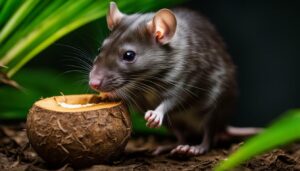Colorado is home to a thriving population of beavers, making them an important part of the state’s wildlife. These native creatures play a crucial role in Colorado’s ecosystem by slowing water, reducing erosion, and expanding riparian habitats. While their activities can sometimes cause conflicts with humans, such as blocking irrigation water and flooding roads, they are recognized by the Colorado Parks and Wildlife (CPW) as a priority Wetlands Program species.
Key Takeaways:
- Beavers are native to Colorado and have a robust population.
- They provide ecological benefits such as slowing water and expanding riparian habitats.
- Beaver activities can cause conflicts with humans.
- The Colorado Parks and Wildlife recognizes the importance of beavers and has prioritized their conservation.
- Various measures can be taken to protect properties from beaver activities.
The Role of Beavers in Colorado’s Ecosystem
Beavers in Colorado play a vital role in maintaining the state’s ecosystem and supporting its diverse wildlife. These industrious creatures are not only known for their iconic dams but also for the ecological benefits they bring to the landscape. By constructing their dams, beavers slow down water flow, reducing erosion and sedimentation. This helps to create diverse wetland habitats, known as riparian areas, which are essential for the survival of many plant and animal species.
One of the most significant contributions of beavers is the expansion of riparian habitats. Their dams create ponds and wetlands, providing crucial water sources for various wildlife species. These habitats become breeding grounds for amphibians, fish, and waterfowl, enhancing biodiversity in Colorado. The presence of beavers also leads to an increase in the abundance of plant species, as the flooded areas provide suitable conditions for the growth of aquatic vegetation.
The Importance of Beavers for Colorado’s Water Systems
Furthermore, beavers contribute to the overall health of Colorado’s water systems. Their dams help to regulate water levels and store water during dry periods, replenishing groundwater resources. By creating a series of interconnected channels, beavers improve water retention and filtration, which benefits both wildlife and human communities alike. The dams also help to mitigate the impacts of floods by absorbing excess water and releasing it gradually.
However, it is important to strike a balance between the benefits beavers provide and the potential conflicts that can arise with human activities. While beavers’ dam-building activities can cause challenges, such as blocking irrigation channels or flooding roads, there are effective measures that can be taken to manage these issues. The Colorado Parks and Wildlife (CPW) recognizes the importance of beavers and offers guidance and support to mitigate conflicts while promoting the coexistence of beavers and humans.
Overall, beavers are essential players in Colorado’s ecosystem, shaping the landscape and providing valuable benefits to both wildlife and the environment. Understanding their role and implementing appropriate management strategies ensures the conservation of these remarkable creatures and the preservation of the diverse habitats they create.
| Beaver’s Role in Colorado’s Ecosystem | Benefits | Challenges |
|---|---|---|
| Construction of dams | Slows water flow, reduces erosion, and expands riparian habitats | May block irrigation channels and flood roads |
| Expansion of wetland habitats | Increases biodiversity and provides water sources for wildlife | Potential conflicts with human activities |
| Water regulation and filtration | Helps store water, replenish groundwater, and mitigate floods | Requires management to avoid conflicts with human water systems |
Benefits and Conflicts of Beaver Activities
The activities of beavers in Colorado rivers and lakes provide important benefits for the environment, but can also lead to conflicts with human infrastructure. Beavers are known for their ability to slow down water, creating dams that help alleviate flooding and prevent erosion. By constructing their dams, beavers create small ponds that provide habitat for a variety of aquatic life, including fish, frogs, and insects. These ponds also serve as important watering holes for other wildlife, such as birds and mammals.
Furthermore, beavers play a crucial role in expanding riparian habitats. Their dams create wetlands, which are unique ecosystems that support a diverse range of plant and animal species. These wetlands attract a plethora of wildlife, including migratory birds and amphibians. The beavers’ constant felling of trees and building of dams also helps to promote the growth of vegetation along riverbanks, enhancing biodiversity and improving water quality.
However, despite their ecological benefits, the activities of beavers can sometimes clash with human interests. Beavers’ dams and lodges can block irrigation ditches, causing agricultural land to become waterlogged. Additionally, their dams can lead to flooding of roads and infrastructure, posing a risk to human safety. These conflicts between beavers and humans have prompted the need for effective management strategies to strike a balance between conserving beaver populations and protecting human interests.
Strategies for Managing Beaver-Human Conflicts
When it comes to living with beavers in Colorado, there are various measures that can be taken to protect properties from the potential negative impacts of beaver activities. One approach involves wrapping valuable trees with fencing to prevent beavers from gnawing on them. Special pipes and grates can also be installed in culverts and irrigation ditches to control water flow and prevent blockages caused by beaver dams.
Furthermore, education and outreach programs can help raise awareness about the importance of beavers in the ecosystem and provide guidance on coexisting harmoniously with these industrious creatures. By understanding the ecological role of beavers and implementing appropriate management strategies, communities can minimize conflicts and appreciate the ecological benefits provided by these remarkable animals.
| Benefits of Beaver Activities | Conflicts with Human Infrastructure |
|---|---|
|
|
Colorado Parks and Wildlife’s Recognition of Beavers
The Colorado Parks and Wildlife (CPW) recognizes the importance of beavers in the state’s ecosystem and has prioritized their conservation efforts. Beavers play a vital role in maintaining healthy wetland habitats and contributing to the overall ecological balance. As a Wetlands Program species, the CPW is committed to protecting and preserving their populations throughout Colorado.
These industrious creatures provide numerous benefits to their surrounding environment. By building dams and lodges, beavers create wetlands that slow water flow, reduce erosion, and provide habitat for a variety of wildlife species. They also expand riparian areas, which are critical for maintaining water quality and supporting diverse plant and animal communities.
While beavers offer many ecological advantages, their activities can sometimes conflict with human interests. To address this, the CPW encourages cooperation and education to find solutions that benefit both people and beavers. Techniques such as wrapping trees with fencing, installing special pipes and grates, and implementing flow devices can help protect properties from beaver activities while keeping their natural behaviors intact.
| Challenges Associated with Living with Beavers |
|---|
| Blocking irrigation water |
| Flooding roads |
| Impeding drainage systems |
While trapping beavers may seem like a quick fix, it is often not an effective long-term solution for homeowners. Additionally, relocating beavers is not always a perfect solution, as it requires careful consideration of factors such as timing, food availability, and potential conflicts with existing beaver populations. It is crucial to work with local wildlife agencies, like the CPW, to explore alternative options and implement appropriate strategies.
Recognizing the immense benefits beavers bring to Colorado’s ecosystems, ongoing efforts are being made to increase their habitats. These include initiatives like mine cleanup, which restores damaged areas and allows beavers to thrive, as well as projects aimed at improving watershed health. By supporting these endeavors, we can help ensure the long-term conservation and well-being of beavers in Colorado.
Managing Beaver-Human Conflicts
Living alongside beavers in Colorado can present challenges, but there are effective strategies to manage conflicts and protect properties. Beavers are known for their dam-building activities, which can sometimes block irrigation water and flood roads. However, there are measures that can be taken to coexist harmoniously with these industrious creatures.
To safeguard your property from beaver activities, one option is to wrap valuable trees with fencing. This method prevents the beavers from gnawing on the bark and potentially causing tree damage. Additionally, installing special pipes and grates can help control water flow and prevent unwanted flooding while still allowing beavers to construct dams.
Colorado Parks and Wildlife (CPW) acknowledges the importance of beavers in the state’s ecosystem and has prioritized them as a Wetlands Program species. They provide valuable ecological benefits, such as slowing water, reducing erosion, and expanding riparian habitats. Recognizing the mutually beneficial relationship between beavers and their environment, CPW promotes the use of non-lethal management techniques whenever possible.
Strategies for Managing Beaver-Human Conflicts:
- Wrap valuable trees with fencing to protect them from beaver gnawing.
- Install special pipes and grates to control water flow and prevent flooding.
- Consider working with local authorities and wildlife experts for guidance on managing beaver activities.
- Explore alternatives to trapping and relocation, as these may not always be effective or sustainable solutions.
- Education and awareness initiatives can help foster a better understanding of beaver behavior and promote coexistence.
By implementing these strategies and adopting a proactive approach, it is possible to manage conflicts with beavers in Colorado and protect both natural resources and private property. The conservation and preservation of beaver habitats are crucial for the long-term health and balance of the state’s ecosystem.
| Benefits of Beavers | Challenges |
|---|---|
| Slowing water flow | Blocking irrigation water |
| Expanding riparian habitats | Potential flooding of roads |
| Reducing erosion | Tree damage from gnawing |
Trapping and Relocation Considerations
Trapping and relocating beavers in Colorado is a complex process that requires careful consideration of various factors. While trapping can be a short-term solution to address conflicts between beavers and homeowners, it may not always solve the underlying problems. It is essential to understand the challenges associated with trapping and relocation to make informed decisions.
Timing plays a crucial role in the success of trapping efforts. Beavers are most active during spring and fall, making these seasons ideal for trapping. It is important to assess the site and ensure that trapping is conducted when beavers are actively using the area. Additionally, the availability of food sources is an important consideration. Beavers require a reliable food supply, mainly consisting of aspen and willow trees. If there is a lack of suitable food nearby, relocation may not be a viable option.
Another factor to consider is the potential conflicts that may arise from relocating beavers. While relocating beavers to areas with existing populations may seem like a straightforward solution, it can lead to territorial disputes and increased competition for resources. Careful assessment of the receiving habitat is necessary to ensure that it can support additional beaver populations without negatively impacting the existing residents.
Considerations for Trapping and Relocation:
- Timing: Conduct trapping when beavers are actively using the area, preferably during spring or fall.
- Food Availability: Ensure that suitable food sources are present in the receiving habitat.
- Conflicts: Assess the potential conflicts that may arise from relocating beavers to areas with existing populations.
In cases where trapping and relocation are not feasible or effective, alternative measures can be taken to mitigate conflicts with beavers. Wrapping trees with protective fencing, installing special pipes and grates to manage water levels, and employing deterrents can help protect properties while allowing beavers to continue their natural behaviors.
By understanding the complexities of trapping and relocation, homeowners and wildlife management agencies can make informed decisions to protect properties and preserve the important role that beavers play in Colorado’s ecosystem.
Trapping and Relocation Considerations Table:
| Considerations | Importance |
|---|---|
| Timing | High |
| Food Availability | High |
| Conflicts | Medium |
Efforts to Increase Beaver Habitats in Colorado
Various initiatives in Colorado aim to enhance beaver habitats and harness their positive impact on the environment, such as mine cleanup and improving watershed health. Beavers play a crucial role in maintaining a healthy ecosystem, and these efforts strive to ensure their long-term survival and the ecological benefits they provide.
One key initiative is focused on mine cleanup. Abandoned mines in Colorado pose significant environmental risks, including contaminated water, soil erosion, and disrupted habitats. By partnering with organizations and communities, efforts are being made to restore these mine sites and create suitable habitats for beavers. By doing so, not only are the negative impacts of mining mitigated, but the beaver populations can thrive in these restored areas, supporting a healthier ecosystem.
An additional focus is on improving watershed health. Beavers are known for their ability to slow water and create wetland habitats that support a variety of plant and animal species. By improving watershed health and creating favorable conditions for beaver populations, these initiatives help to restore the natural balance of ecosystems. This includes implementing measures such as reestablishing riparian vegetation, removing invasive species, and restoring natural water flow patterns.
Table: Ongoing Initiatives to Increase Beaver Habitats in Colorado
| Initiative | Description |
|---|---|
| Mine Cleanup | Collaborative efforts between organizations and communities to restore mine sites and create suitable habitats for beavers. |
| Watershed Restoration | Measures taken to improve watershed health, including the reestablishment of riparian vegetation and restoration of natural water flow patterns. |
| Partnerships and Education | Working with local communities and educational institutions to raise awareness about the importance of beaver habitats and promote conservation efforts. |
As these initiatives continue, it is hoped that the population of beavers in Colorado will rebound and thrive. By recognizing the value of beavers in the ecosystem and implementing targeted strategies, Colorado is taking important steps to protect these fascinating creatures and the habitats they create.
Factors Impacting Beaver Population in Colorado
The population of beavers in Colorado has not fully recovered from past depletion, with various factors affecting their numbers, such as hunting and habitat degradation. Beavers were historically hunted for their prized fur, leading to a significant decline in their population. Although hunting regulations have been implemented to protect beavers, it takes time for their numbers to rebound.
Habitat degradation also poses a significant challenge to the recovery of beaver populations. Riparian areas, which are crucial for beaver habitat, have been impacted by human activities such as dam construction, agriculture, and urban development. These disturbances disrupt the natural flow of water and destroy the riparian vegetation that beavers rely on for food and construction materials.
| Factors Impacting Beaver Population in Colorado |
|---|
| Lack of riparian plant life |
| Grazing by elk and cattle |
Furthermore, the presence of large herbivores such as elk and cattle can also contribute to the stagnation of beaver populations in Colorado. Grazing by these animals can lead to overgrazing, resulting in the depletion of riparian plant life that beavers rely on for food and shelter.
Efforts to restore and protect beaver habitats, such as riparian restoration projects and wildlife management plans, are essential for the long-term recovery of beaver populations in Colorado. By addressing the factors impacting their numbers and providing suitable habitats, we can enhance the chances of beavers thriving once again in the state’s ecosystems.
Beaver Conservation in Rocky Mountain National Park
Conservation efforts in Rocky Mountain National Park consider the significance of beavers and explore the possibility of their reintroduction. Beavers play a vital role in shaping ecosystems by creating wetlands and enhancing biodiversity. Their dams slow water flow and help in reducing erosion, while their activities expand riparian habitats. Recognizing the importance of beavers, the park is evaluating the potential benefits of reintroducing these industrious creatures.
Reintroducing beavers in Rocky Mountain National Park could have several positive impacts. Their dams would help restore wetlands and improve water quality in the park’s rivers and streams. By creating ponds, beavers provide habitats for a variety of aquatic species, supporting overall ecosystem health. These efforts align with the park’s commitment to preserving and enhancing wildlife habitat.
However, the reintroduction of beavers requires careful consideration. Factors such as timing, food availability, and potential conflicts with humans and other wildlife must be carefully managed. The park’s conservation experts are studying the feasibility and potential challenges associated with beaver reintroduction, ensuring a comprehensive approach to wildlife management.
| Benefits of Beaver Reintroduction | Considerations for Beaver Reintroduction |
|---|---|
|
|
As conservation efforts continue in Rocky Mountain National Park, the exploration of beaver reintroduction serves as a testament to the park’s commitment to wildlife conservation and habitat restoration. By carefully considering the ecological benefits and potential challenges, the park aims to strike a balance that will benefit both the ecosystem and visitors to this majestic natural wonder.
Conclusion
Beavers in Colorado contribute significantly to the state’s ecosystem and wildlife, and their conservation is crucial for maintaining a healthy and balanced environment. The beaver population in Colorado is robust, and these native animals play a vital role in the state’s ecological balance.
Beavers provide numerous benefits to Colorado’s ecosystem, including slowing water flow, reducing erosion, and expanding riparian habitats. They create wetlands that support a diverse array of plant and animal species, fostering biodiversity and improving overall habitat quality.
However, beaver activities can sometimes conflict with human interests, such as blocking irrigation water and flooding roads. The Colorado Parks and Wildlife (CPW) recognizes the importance of beavers and has prioritized them as a Wetlands Program species, aiming to strike a balance between wildlife conservation and human needs.
To mitigate potential conflicts with beavers, homeowners can take proactive measures such as wrapping trees with fencing and using special pipes and grates. Trapping beavers may be a short-term solution, but it may not entirely solve the problems faced by homeowners. Relocating beavers is also not always a perfect solution, as it involves considerations like timing, food availability, and potential conflicts with other beaver populations.
Ongoing efforts in Colorado focus on increasing beaver habitats for their long-term benefits. These initiatives include mine cleanup to restore beaver-friendly environments and improve watershed health. However, the population of beavers in Colorado has not fully recovered from past depletion. Factors such as hunting, the lack of riparian plant life, and grazing by elk and cattle continue to contribute to their stagnation.
In Rocky Mountain National Park, beaver conservation is an integral part of wildlife management plans. The park authorities are considering the possible reintroduction of beavers to promote ecological balance and enhance the park’s overall biodiversity.
In conclusion, the presence of beavers in Colorado is essential for maintaining a healthy ecosystem and preserving wildlife diversity. Protecting and conserving these unique creatures will ensure the continued well-being of Colorado’s environment for future generations.
FAQ
Are there beavers in Colorado?
Yes, beavers are native to Colorado and their population is robust.
What role do beavers play in Colorado’s ecosystem?
Beavers play an important role in Colorado’s ecosystem by slowing water, reducing erosion, and expanding riparian habitats.
What are the benefits and conflicts associated with beaver activities?
Beaver activities provide ecological benefits, such as slowing water and expanding riparian habitats. However, they can also cause conflicts with humans, such as blocking irrigation water and flooding roads.
Why are beavers recognized by the Colorado Parks and Wildlife?
The Colorado Parks and Wildlife (CPW) recognizes the importance of beavers and has prioritized them as a Wetlands Program species in their wildlife conservation efforts.
How can I manage conflicts with beavers?
Various measures can be taken to protect properties from beaver activities, such as wrapping trees with fencing and using special pipes and grates.
Is trapping or relocation a solution to dealing with beavers?
Trapping beavers is a short-term solution that may not solve homeowner’s problems, and relocation of beavers is not always a perfect solution. Factors such as timing, food availability, and potential conflicts need to be considered.
What efforts are being made to increase beaver habitats in Colorado?
Efforts are being made in Colorado to increase beaver habitats for their long-term benefits, such as mine cleanup and improving watershed health.
What factors impact the beaver population in Colorado?
Various factors, such as hunting, lack of riparian plant life, and grazing by elk and cattle, contribute to the stagnation of the beaver population in Colorado.
What is the conservation plan for beavers in Rocky Mountain National Park?
Conservation and wildlife management plans in Rocky Mountain National Park also consider the possible reintroduction of beavers as part of their efforts in wildlife conservation.




